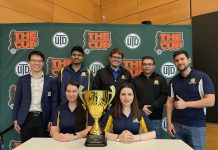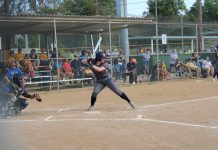Clarification: Chief Financial Officer Greg Gunderson’s quote about the timeframe of Webster’s future projects has been clarified from its original text in the print edition.
In the past two decades Webster University athletics has grown from an organization which did not have NCAA affiliation until 1984 to a school which now boasts the second most St. Louis Intercollegiate Athletic Conference (SLIAC) titles of any school across all sports. Webster has expanded from eight sports in 1992 to 14 in 2014 and in the past two years have added JV men’s and women’s soccer and indoor track.
Webster Chief Financial Officer Greg Gunderson said that the athletic department is a recruiting force and a way for the university to gain recognition.
In addition, Gunderson said that the university has increased their investment in the athletic department since 2011. Gunderson said that total money spent on salaries has risen from $726,000 to $927,000, the benefits for employees has risen from $172,000 to $214,000 and operating cost has risen from $298,000 to $323,000 over that time period. In total the university’s investment in the athletic department has risen from $1,196,000 to $1,464,000 from 2011 to 2015.

“You look at our enrollment growth from 2011 to today and a chunk of it can be directly attributed to the success athletics has had, in expanding its offerings in a logical way, and recruiting more students,” Gunderson said.
From 2011-12 to 2014-15 enrollment has risen from 2,372 undergraduate students at the Webster Groves Campus to 3,002 students in 2014-15.
Interim Chief Enrollment Officer Robert Parrent said that the university has sought to build a model for incremental growth within the athletic department.
“It’s not just growth for growth’s sake — it’s strategic growth,” Parrent said.
Still, despite success in the past, first year Athletic Director Scott Kilgallon said that the athletic department has huge needs in its efforts to grow, especially space.
“The bigger issue is getting that space where you can do programs and events. In my mind, the university may be at a different tipping point than they were a couple of years ago because (the university) understands that athletics helps attract and grow enrollment. I think the school needs to seriously look at when there is an opportunity to buy something that’s close to campus,” Kilgallon said.
Kilgallon said to his knowledge several facilities had been up for sale in the past few years in the St. Louis area, including the St. Louis Soccer Park and the Sports Center on Langley Avenue. According to a Journal article, Niagra Worldwide purchased the building shortly after the Sports Center closed. According to an article from the St. Louis Post-Dispatch, St. Louis Scott Gallagher Soccer Club acquired the Soccer Park from Jeff Cooper and St. Louis Soccer United for an undisclosed amount on Aug. 10, 2011.
Webster had been playing soccer games at Soccer Park prior to that time. While Kilgallon recognizes that the university might not have been in a position to make a play for a facility like Soccer Park then, it is these sort of opportunities he would like the university to consider now.
Kilgallon compared owning athletic facilities to owning a house, where as an owner the university would be able to dictate the terms of usage.
Gunderson took a slightly different view — but used the same analogy.
“We think that if we buy a house we own it. Very few people pay off a 30 year mortgage,” Gunderson said. “Sometimes ownership is a very artificial construct. Sometimes leasing actually gives you more flexibility.”
Webster currently leases a majority of its athletic facilities including St. Louis Soccer Park in Fenton and GCS Ball Park in Sauget, Illinois. Soccer Park is located approximately 10 minutes from campus, and GCS Ball Park is approximately 25 minutes from campus.
In the case of Soccer Park, Webster entered into a 15-year lease with Scott Gallagher Soccer Club the current owners of the Soccer Park. Webster has agreed to pay $600,000 over the 15-year lease in addition to between $500,000 and $1 million that the university paid for renovations of the Soccer Park — including new field turf — in 2012. In addition the university holds the right of first refusal if the soccer club chooses to sell.
The university’s lease with GCS Ballpark is set to expire after next season. This means that the university will have to either negotiate a new lease, or find a new facility to house the baseball team. Potentially, it could lead to increased rental fees, one of Kilgallon’s concerns about leasing.
Video by Macy Salama
An Issue of Space
Bill Kurich has coached the baseball team for nine seasons and last season led the baseball team to a number one national-ranking in division III—a first for Webster. He has spent every season at GCS Ball Park, which he describes as outstanding.
However, he was more critical of the weight room located in the University Center (UC) on campus.
“You’ll have tour guides walking prospective students through, and we’ll have our guys out there working out right in the middle of the hallway,” Kurich said. “You bring a prospective high school student in and their high school weight room was six times the size. . . Obviously that’s a scenario where we’re behind the eight-ball in recruiting.”
Last year the university added new equipment to the weight room at the request of the Delegates Agenda. However, the issue of space has persisted.
Junior cross-country runner David Lambus said that despite the new equipment, the weight room still has a space problem.
“They need to expand, not just get new stuff,” Lambus said. “The same stuff is working just as fine, as now so, if anything they need more stuff.”
Gunderson said that the university is currently looking at ways to rededicate space in the UC but recognizes that it is a complicated issue. The 2012 master plan calls for a new UC.
Gunderson said that the student union and the recreational facility, which are laid out in the master plan, are both enhancements meant to address both athletics and other campus-life elements.
He also said that university is still working on plans with the interdisciplinary science building (IDS), the electrical substation, the parking garage and the addition left-hand turn lane onto Garden from Edgar. Those matters will have to be attended to, before the university can begin to address other objectives in the master plan.
“My hope is five years from today, everything in that package (substation, garage, IDS and the left-hand turn lane) will be done,” Gunderson said. “The city has to approve our designs and we have to get permission to occupy the buildings. I think we could do everything in three years, but I think it’s going to take something more like five years.”
“Our (current) university center will not get us where we want to go in the next 20 years. We need more student-life experience, not less,” Gunderson said.
Gunderson also said that the university has looked at repurposing pool space, but that the people who use the pool (students, faculty, residents) probably wouldn’t perceive that very positively and that nothing is definitive yet.
For his part, Kilgallon said that it would cost around one million dollars to build a mezzanine in the pool area to add more office space for the athletic department. In addition he said that the space at the pool would not solve all of the athletic department’s problems. Instead, Kilgallon said the university should try and look at other options.
“You start to look at the potentials out there,” Kilgallon said. “On campus (would be) tough; you’ve got Eden, you’ve got the Sports Center, you’ve got the Bud Dome, which in my world —you’ve got the rental fee but if they ever opened up for sale again we’d have to take a good look at them.”
(The Sports Center and the Bud Dome are indoor practice facilities for sports like baseball, softball and soccer. The Sports Center is located three miles from campus, while the Bud Dome is located eight miles from campus.)
Gunderson said that he is not opposed to the university buying or leasing facilities closer to campus — provided that it made sense for the university to do so.
Recruitment
Robert Parrent once played NCAA division-I baseball at Western Kentucky University. The Cincinnati Reds even showed interest in him for a time. Parrent said that while he enjoyed his time playing baseball he thinks that division-III athletics is the best possible way for higher education to be structured.
“If I could do it all over again, I would go to a place like Webster instead,” Parrent said.
Freshman goalkeeper Rachael Ainsworth made the decision to go to Webster last year. Ainsworth said that there were many factors that motivated her choice, including Webster’s study abroad program and academic options. But she also said that she wanted to play soccer and that the quality of the Soccer Park struck her. She says she was not bothered by the commute from Webster to Fenton nearly every day.
“I’m okay with the drive when I get to play on a field like that every day,” Ainsworth said.
Senior volleyball player Jenny Howard doesn’t face a commute to her practice, as the volleyball team plays at Grant Gymnasium on Webster’s campus. However, she does feel for teams like the baseball team who do play their home games in Sauget. Illinois.
“It sucks that it’s (GCS Ball Park) so far away,” Howard said. “It is unfortunate with our issues with being landlocked. We’re (the volleyball team) really lucky that we play on campus. I feel so bad for them (the baseball team.)”



